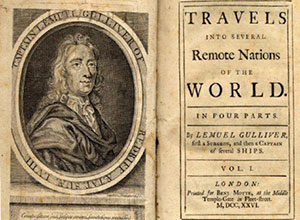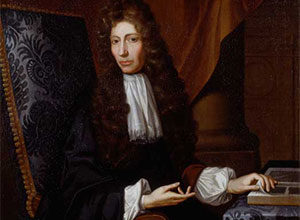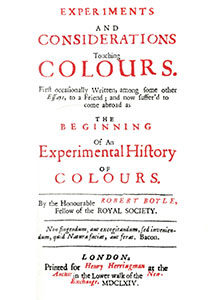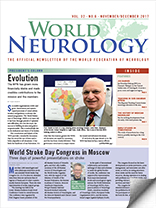The blind organ player of Maastricht
By Peter J. Koehler

Figure 1. The title page of Jonathan Swift’s 1726 edition of Gulliver’s Travels.
The study of synesthesia has a long history, possibly starting in the 17th century. A search in PubMed learns that the earliest entry is from 1947. During the first decades after that, psychologists seem to have been the main group interested in the subject. However, since the 1980s, basic neuroscientists as well as clinical neuroscientists have become interested, as is witnessed from the same source (428 hits since 1947, 419 since the 1980s).
Synesthesia is defined as “a condition in which stimulation of one sensory modality causes unusual experiences in a second, unstimulated modality.”1 The most frequent types of synesthesia include letter-color synesthesia, but several other types are known, such as color-taste and sound-color synesthesia.

Figure 2.Robert Boyle.
The phenomenon has been reported by famous synesthetes. In his 2007 review, John Pearce mentioned musicians Jean Sibelius, Nicolai Rimsky-Korsakow, Duke Ellington, Franz Liszt, Olivier Messiaen* and writer Vladimir Nabokov.2 French pianist Hélène Grimaud first noticed it when she was working on the F sharp major prelude from the first book of Bach’s Well-Tempered Clavier:
“I perceived something that was very bright, between red and orange, very warm and vivid: an almost shapeless stain, rather like what you would see in the recording control room if the image of sound were projected on a screen.”3
Gulliver’s Travels and Robert Boyle
Descriptions of synesthesia can be found much earlier than 1947.4 In part 3, “A Voyage to Laputa” of Jonathan Swift’s Gulliver’s Travels (see Figure 1), the fictitious ship surgeon Lemuel Gulliver, visiting the Academy of Lagado (a parody of the Royal Society), learns about:
“a man born blind, who had several apprentices in his own condition. Their employment was to mix colors for painters, which their master taught them to distinguish by feeling and smelling. It was indeed my misfortune to find them at that time not very perfect in their lessons, and the professor himself happened to be generally mistaken. The artist is much encouraged and esteemed by the whole fraternity.”5
It has been argued that Swift’s ideas in this part of Gulliver’s Travels have been inspired by the work of contemporary scientists, including members of the Royal Society. In this case, Swift’s source seems to be Robert Boyle, the philosopher and chemist (well-known from his gas law: Pressure x Volume = constant!), fellow of the Royal Society, who published Experiments and Considerations Touching Colors. (See Figures 2 and 3.)6

Figure 3. The title page of Robert Boyle’s book.
In this book, he described all sorts of color experiments, and he became subject to Swift’s parody.
From the book, it is clear that Boyle was critical to the story that he had learned from his informant, the gentleman scientist and physician John Finch.
Boyle wrote:
“… Wherefore I confess, I propos’d divers Scruples, and particularly whether the Doctor had taken care to bind a Napkin or Hankerchief over his Eyes so carefully, as to be sure he could make no use of his Sight, though he had but Counterfeited the want of it, to which I added divers other Questions, to satisfie my Self, whether there were any Likelihood of Collusion or other Tricks. But I found that the Judicious Doctor having gone farr out of his way, purposely to satisfie Himself and his Learned Prince about this Wonder, had been very Watchfull and Circumspect to keep Himself from being Impos’d upon. And that he might not through any mistake in point of Memory mis-inform Me, he did me the Favour at my Request, to look out the Notes he had Written for his Own and his Princes Information, the summ of which Memorials, as far as we shall mention them here, was this, That the Doctor having been inform’d at Utrecht, that there Lived one at some Miles distance from Maestricht [Utrecht and Maastricht, both cities in the Netherlands], who could distinguish Colours by the Touch, when he came to the last nam’d Town, he sent a Messenger for him, and having Examin’d him, was told upon Enquiry these Particulars.”
Boyle’s informant John Finch had studied at Padua, was a fellow of the Royal Society, and was professor of anatomy in Pisa, later becoming ambassador in Constantinople. He corresponded with his patron prince Leopoldo (de Medici, son of Cosimo II) of Tuscany, who was interested in technology and science. From another source, we learn that Finch indeed visited the town of Maastricht for this purpose: “We spent many days at Mastricht, in talks, and in making many experiments with him [Vermaasen]; and really it is marvelous to see this man know by touch a pack of cards, play at piquet.” Finch paid a visit to the Netherlands not only to study the case in Maastricht, but also to learn more on “signor Bilzio,” the well-known Louis de Bils in Rotterdam, who seemed to have found a method to preserve bodies for dissection for a long period, using expensive materials and asking a huge amount of money (120.000 guilders) for the secret.7,8
Boyle continued:
“That the Man’s name was John Vermaasen, at that time about 33 years of age; that when he was but two years old, he had the small pox, which rendred him absolutely blind: That at this present he is an organist, and serves that office in a publick quire. That the doctor discoursing with him over night, the blind man affirm’d, that he could distinguish colours by the touch, but that he could not do it, unless he were fasting; any quantity of drink taking from him that exquisitness of touch, which is requisite to so nice a sensation. That hereupon the doctor provided against the next morning seven pieces of ribbon, of these seven colours, black, white, red, blew, green, yellow, and gray, but as for mingled colours, this Vermaasen would not undertake to discern them, though if offer’d, he would tell that they were mix’d.”
Some later authors state that Vermaasen was not a real synesthete as he did not report “seeing” the colors.9 Larner, however, opined that he at least had characteristics of a synesthete. It was involuntary or automatic, consistent (at least over four or five trials), and generic or categorical. Moreover, synesthesia is not rare in blind people.4
Reports of synesthesia have been mentioned in Greek antiquity and later by Newton and by Goethe. John Locke wrote about “a studious blind man who bragged one day that he now understood scarlet was … the sound of a trumpet” in his Essay Concerning Human Understanding (1690; “Of the names of simples ideas”; book III, chapter IV).
The Albino Synesthete
A better early example of synesthesia was Georg Tobias Ludwig Sachs (1786-1814), who wrote a dissertation on albinism (on himself and his sister) in 1812: Historiae naturalis duorum leucaetiopum: Auctoris ipsius et sororis eius [A Natural History of Two Albinos, the Author and his Sister.] It was translated into German and should be considered against the background of Goethe’s Farbenlehre (1810).9 Jewanski et al. consider it the “first convincing account of synesthesia” and translated several parts into English, including §. 158:
“Particularly those things which form a simple series; e.g., numbers, the days of the week, the time periods of history and of human life, the letters of the alphabet, intervals of the musical scale, and other such similar things, adopt those colors. These introduce themselves to the mind as if a series of visible objects in dark space, formless and noticeably of different colors. With some, the idea of the color is so dark that one can scarcely differentiate between the colors; with others, it is much more clear. Those individual members of such rows which show up outside of the row retain their own colors, but more weakly. In addition, others which refer back to no series have their own color; e.g., cities (even those never seen) and the timbres of musical instruments.”9
On French composer Oliver Messiaen
“I see colors when I hear sounds,” Messiaen explained to the French critic Claude Samuel in 1988, “but I don’t see colors with my eyes. I see colors intellectually, in my head.” He found, he said, that if a particular sound complex was repeated an octave higher, the color he saw persisted, but grew paler. If the octave was lowered, the color darkened. Only if the sound complex was transposed into a different pitch did the color inside Messiaen’s head radically change.”
From Geoffrey Brown How Olivier Messiaen Heard in Color, 25/01/08 Times newspaper.
Examples of Sachs’ perceptions were: “In the alphabet, A and E are vermilion, A however is more cinnabar, E is more inclined to rose; I is white; O orange; U black; Ue (ü) gray; C pale-ash-colored; D yellow; F dark gray; H is bluish ash-colored; K nearly dark green (uncertain); M and N white, S dark-blue; W brown.”
With respect to music, he noted that “The tones in the musical scale depend on the letter with which they are designated, and these relate also to the half-tones, which derive from them. Although the letters g and b actually do not carry a color trace, nevertheless the fifth tone (g) is recognized as green (uncertain) and the first quarter tone (b) is seen quite clearly by the ash gray color.”9
A few decades later, polymath Sir Francis Galton, Charles Darwin’s half-cousin, published a paper on “Visualized Numerals” in Nature (Jan. 15, 1880). He estimated it to occur in 3 percent of men and 6 percent of women. Today, it is indeed estimated to occur in about 4 percent of the adult population.
Letter-color synesthesia is the most common type. It is involuntary and reproducible. It may be inheritable and occurs in women more often than in men. It is often combined with eidetic memory, but like in the case of Russian neurologist/psychologist Alexander Luria’s Shereshevsky in Mind of a Mnemonist, these mainly concern case reports. Although there has been much speculation on synesthesia, serious scientific research has also been done. The journal Cortex dedicated a special issue to synesthesia in 2006.
The American neurologist Ramachandran found an association between synesthesia and creativity, but a causal relationship could not be proven.10 There is at least an increased incidence of synesthesia among artists. The phenomenon has been linked to the fusiform gyrus.
In the introduction of a recent study in the British Journal of Psychology, it was stated that up to now, “synesthesia may be associated with differences in creativity, cognition, personality, and mental imagery, but these factors have not been examined simultaneously in a systematically recruited sample.”
The authors tried to replicate previous findings with more robust scientific methods, in particular with respect to unbiased recruitment of synesthetes, and indeed found differences between synesthetes and controls, but were more cautious with the interpretation.
“Enhanced abilities in some areas of creativity, personality, cognition, and mental imagery may have developed because of experiences across time and cannot be attributed directly to synesthesia without further evidence.”11 As is concluded so often, further study is needed into this fascinating phenomenon. •
References
- Hubbard EM, Ramachandran VS. Neurocognitive mechanisms of synesthesia. Neuron. 2005;48:509-20.
- Pearce JMS. Synaesthesia. Eur Neurol 2007;57:120–124
- Cavallaro D. Synesthesia and the arts. Jefferson (NC) and London, 2013, p.36.
- Larner AJ. A possible account of synaesthesia dating from the seventeenth century. J Hist Neurosci. 2006;15:245-9.
- Swift J. Gulliver’s Travels. Prestwick House Literary Touchstone Classics, 2005 (original publication 1726), p. 154.
- Boyle R. Experiments and considerations touching colours. London, Herringman, 1664.
- Malloch A, Finch J. Finch and Baines a Seventeenth Century Friendship. Cambridge University Press, 1917, p.36
- Cook HJ. Matters of exchange. Commerce, Medicine, and Science in the Dutch Golden Age. New Haven & London, Yale University Press, 2007, p.268-76.
- Jewanski J, Day SA, Ward J. A colorful albino: the first documented case of synaesthesia, by Georg Tobias Ludwig Sachs in 1812. J Hist Neurosci. 2009;18:293-303.
- Brang D, Ramachandran VS. Survival of the synesthesia gene: why do people hear colors and taste words? PLoS Biol 2011;9:e1001205.
- Chun CA, Hupé JM. Are synesthetes exceptional beyond their synesthetic associations? A systematic comparison of creativity, personality, cognition, and mental imagery in synesthetes and controls. Br J Psychol. 2016;107:397-418
